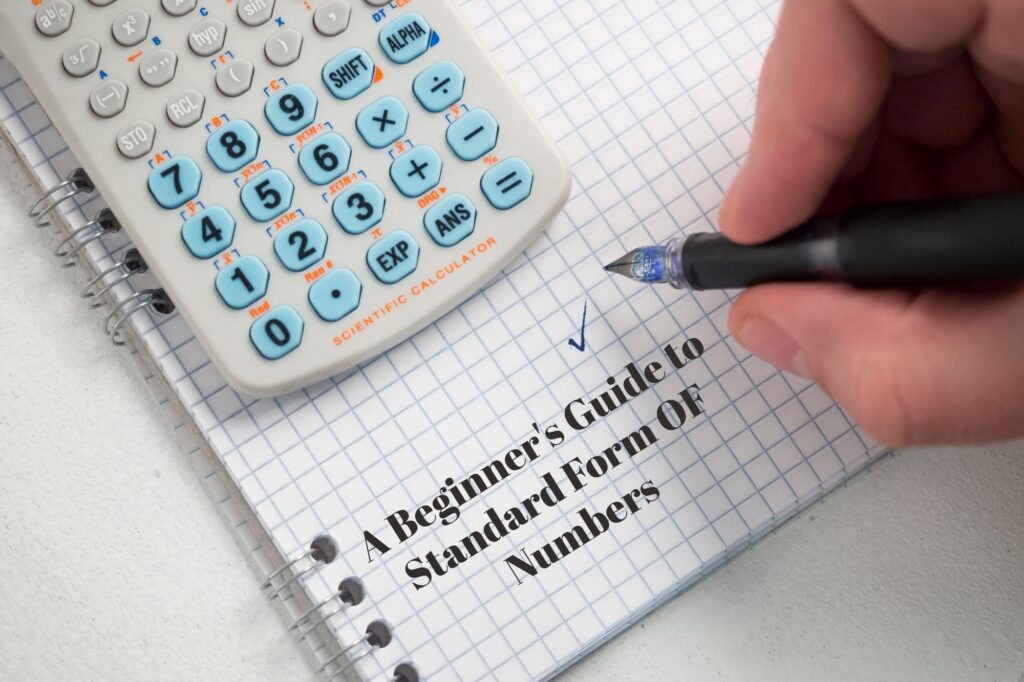"Let's Share, Sharing is Caring"
The term “standard form” is a fundamental concept used widely in various fields. It refers to a common accepted way of representing something by making it easier for people to understand and work with. In this article, we’ll explore the basic concept of standard form, and its historical significance.

We’ll also provide a brief overview of the main sections covered in this article. To help you grasp the concept better, we’ll conclude by solving some examples that illustrate how standard form is used in practice. Let’s dive into the world of standard form and its practical applications.
How to Write Numbers in Standard Form
Writing numbers in standard form involves two main components: the mantissa (or coefficient) and the exponent. Here’s a step-by-step guide on how to do it:
Step 1: Identify the Mantissa
The mantissa is the part of the number that contains the significant digits. In other words, it’s the part of the number that is not zero. For example:
In the number 3200
The mantissa is 3.2.
Step 2: Determine the Exponent
The exponent represents the power of ten by which you need to multiply the mantissa to obtain the original number. To find the exponent; count the number of places you moved the decimal point to the right to get the mantissa.
In our example of 3200. The exponent is 3 because we moved the decimal point three places to the right to get 3.2.
Step 3: Combine the Mantissa and Exponent
Now, combine the mantissa and exponent using the multiplication sign (*) and the power of ten (10).
In our example:
The number 3200 in standard form is written as 3.2 * 103.
Converting Scientific Notation to Standard Form
Scientific notation is another way to express very large or very small numbers, often used in science and engineering. Converting scientific notation to standard form is straightforward:
- Take the coefficient from the scientific notation.
- Raise 10 to the power of the exponent from the scientific notation.
- Multiply the coefficient by the result from step 2.
For example:
If you have the number 6.7 * 104 in scientific notation
In standard form:
it becomes 67000.
Examples of Standard Form in Real-Life Situations
Standard form is not just a mathematical concept; it has practical applications in real-life situations. Here are some examples:
Finance
In the world of finance, standard form is used to represent large sums of money, such as national debts or corporate assets. For instance:
A country’s national debt of $25 trillion can be expressed as 2.5 * 1013 dollars in standard form.
Astronomy
Astronomers often deal with astronomical distances and numbers. They use standard form to represent the distances between celestial objects. For instance:
The distance between the Earth and the Sun is approximately 9.46 * 107 miles.
The Significance of Standard Form in Math and Science
Standard form is important in mathematics and science for several reasons:
- Ease of Comparison: It allows for easier comparison of numbers with varying magnitudes. When numbers are expressed in standard form, their exponents indicate their relative sizes.
- Simplifies Calculations: Standard form simplifies complex calculations, making them more manageable and less prone to errors.
- Scientific Notation: It serves as a bridge to scientific notation, which is essential in scientific research and engineering.
Benefits of Using Standard Form in Calculations
The use of standard form offers several advantages in calculations:
Clarity
Standard form provides a clear and concise representation of numbers, making it easier to work with large or small quantities.
Error Reduction
By eliminating unnecessary zeros or place values, standard form reduces the likelihood of errors in calculations.
Compatibility
Standard form is compatible with scientific notation, making it a versatile tool in scientific and engineering fields.
Numerical Examples
Example 1: Writing a Large Number in Standard Form
Express 72000000 in standard form.
Solution:
Step 1: Identify the mantissa
In the number 72000000 the mantissa is 7.2.
Step 2: Determine the exponent
Count the number of places you moved the decimal point to the right to get the mantissa.
In this case: You moved it 7 places to the right.
Step 3: Combine the mantissa and exponent
Write the number in standard form as 7.2 * 107.
Therefore, 72000000 in standard form is 7.2 * 107.
Example 2: Converting Scientific Notation to Standard Form
Convert 4.5 * 106 to standard form.
Solution:
Step 1: Take the coefficient from the scientific notation
The mantissa is 4.5.
Step 2: Raise 10 to the power of the exponent from the scientific notation
106 equals 1000000
Step 3: Multiply the mantissa by the result from step 2:
= 4.5 * 1000000
= 4500000.
4.5 * 106 in standard form is 4500000.
Example 3: Performing Calculations with Standard Form
Multiply 2.5 * 104 by 3.0 * 103 and express the result in standard form.
Solution:
Step 1: Multiply the mantissas:
2.5 * 3.0 = 7.5.
Step 2: Add the exponents
104 multiplied by 103 equals 107
Step 3: Combine the mantissa and exponent:
Write the result in standard form as 7.5 * 107.
(2.5 * 104) * (3.0 * 103) in standard form is 7.5 * 107.
Conclusion and Summary
Standard form is a valuable mathematical and scientific technique for representing numbers with large variations in magnitude. It simplifies calculations, enhances clarity, and facilitates comparisons. Whether you’re dealing with financial data, astronomical distances, or scientific measurements, standard form makes complex numbers more manageable.
